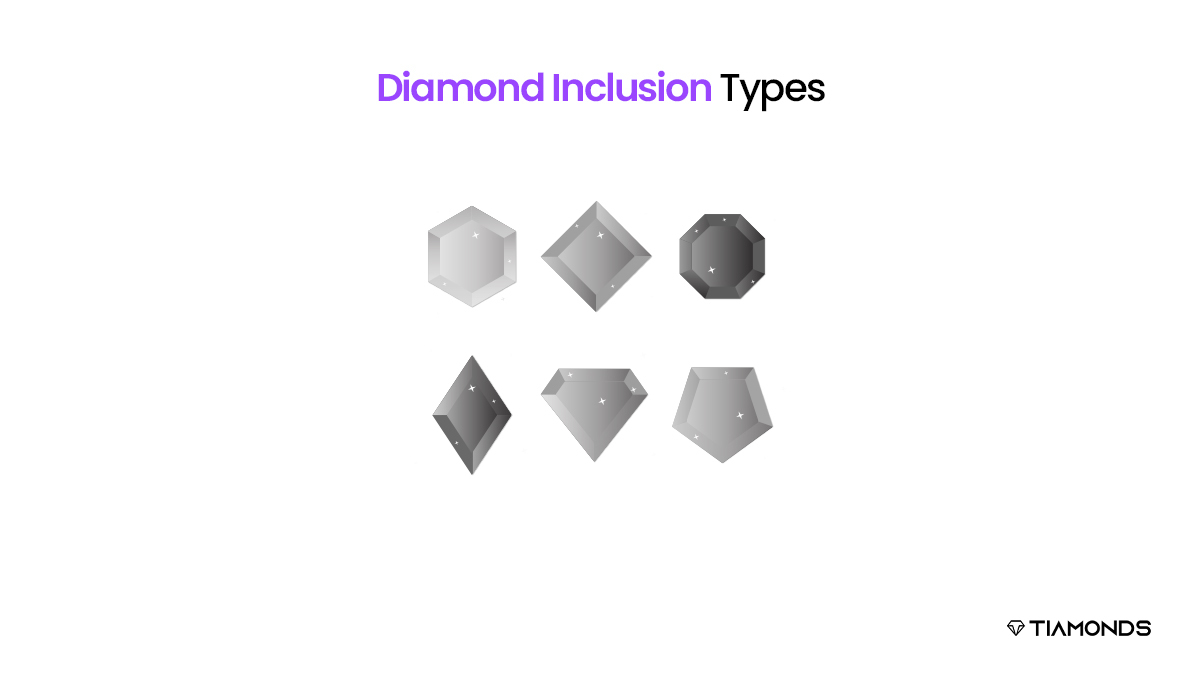Diamonds are the definition of luxury and expensive goods, as their radiance and enduring beauty capture the essence of many. These valuable stones are not, however, exquisite. In fact, virtually every diamond contains inherent internal or external properties known as inclusions. Understanding diamond inclusions is crucial for both purchasers and enthusiasts, as they have a significant impact on the value and overall appearance of a diamond.
Inclusions in diamonds come in a variety of forms and have a variety of effects, ranging from those that are only apparent to an experienced evaluator who works in a lab under a microscope, to highly included diamonds with flaws noticeable to the unaided eye to highly included stones whose inclusions negatively affect brilliance and/or durability. Inclusions allow us to distinguish between natural and synthetic diamonds and serve as “fingerprints” to positively identify each diamond. In some instances, extremely rare inclusions might help us pinpoint the geographical origin of a diamond.
Table of Contents:
ToggleWhat Are Inclusions in Diamonds?
Inclusions in diamonds are either internal or external defects that occur throughout the diamond’s formation in the Earth’s mantle. Minor elements, pressure, and temperature changes are just a few of the factors that produce them. Inclusions can manifest as minute crystals, clouds, feathers, or other structural irregularities. They are like the fingerprints of nature, making each diamond genuinely unique.
Why Do Inclusions in Diamonds Matter?
Let’s begin by discussing inclusions found in conventional white diamonds. Almost all diamonds have inclusions; therefore, one should strive for an eye-clean diamond, which has no inclusions observable to the naked eye. The ease with which defects are visible at 10x magnification is what determines clarity from there (more on this below!).
Keep in mind that the selling price of a diamond may rise significantly between two and three clarity classifications, despite the fact that it is frequently impossible to distinguish between them. Do not pay more for what cannot be seen! Sometimes, inclusions in diamonds can have a negative impact. impact on durability. A surface-reaching inclusion, for instance, is more than just an aesthetic concern; it can increase the diamond’s susceptibility to chipping or shattering.
Types of Diamond Inclusions
Clouds
These clusters of minute white inclusions resemble clouds. Inclusions can affect a diamond’s clarity, but they may additionally give it a nebulous, ethereal appearance. If an eye-clean diamond is the requirement, avoid inferior clarity-grade diamond inclusions with cover-ups.
Feathers
These are internal diamond fractures that resemble white feathers. Depending on their shape and position, they may only be apparent from particular perspectives. Unless they are surface-reaching, feathers generally do not impair durability.
Needles
These inclusions are long and slender, resembling needles. Typically, they are extremely minute and are only visible under a microscope. Visible inclusions can affect a diamond’s clarity, but they can also contribute texture and pattern.
Identical Wisps
These inclusions in diamonds resemble braided sugar or artificial spiderwebs. If it is a minuscule wisp, it may be undetectable, but bigger groups can impair visibility.
Pinpoints
Pinpoints are the microscopic crystals that can form within a diamond. They resemble microscopic sugar particles and are not cause for concern; they are only visible under magnification.
Knots
A knot is a diamond crystal that extends to the stone’s surface. As with all inclusions that reach the surface, knots can cause endurance issues and should be prevented for a stone that continues forever.
Cavities
A cavity is a crack on a diamond’s surface. During the refining process, a fragment of a feather or crystal often breaks off and leaves a cavity.
Internal Cultivation
The internal graining of diamond inclusions consists of clusters of curved or straight lines that can be colored, transparent, or white. Avoid low-clarity diamonds with internal graining if looking for an eye-clean stone.
Conclusion
Diamond inclusions are the nature-made characteristics that contribute to making each diamond genuinely unique. Understanding the varieties and importance of inclusions is crucial for determining the quality and value of a diamond. By contemplating the effect of inclusions in diamonds on a diamond’s clarity, brilliance, and appearance as a whole, one can make a well-informed decision when choosing a diamond that fits their preferences and budget. Remember that a diamond’s beauty extends beyond its flawless exterior, and appreciating its uniqueness can add a measure of charm and personality to the prized gem.




